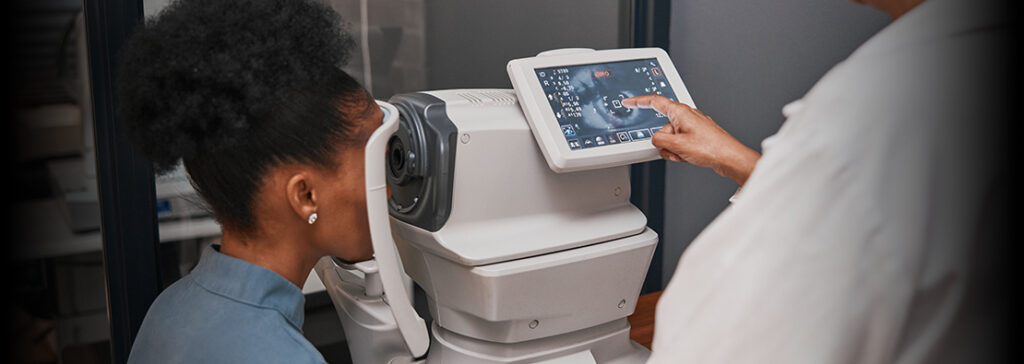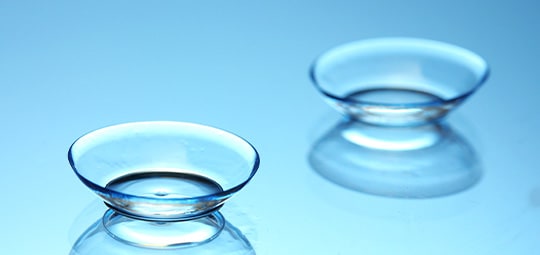Personalized Care for Your Eyes
Our wide variety of current technology offers deeper insights into your eye health, which helps us create personalized treatment plans.
Comprehensive eye exams and early diagnosis are key to promoting optimal eye health. Using our technology, we can detect vision problems in their early stages and provide quality care that you and your family can count on.
We understand the delicacy of eye health, and our team is here to provide treatments rooted in compassion as we build a strong relationship with you.
Your eyes are the gateway to capturing life’s beautiful memories—don’t miss a moment.
Request AppointmentHow Optos Imaging Tells a Detailed Story of Your Eye Health
Optos ultra-widefield retinal imaging, also known as an optomap image, is a powerful tool that enables eyecare professionals to detect and diagnose various eye conditions and diseases. Optos can aid in the detection of:
- Retinal detachment
- Diabetic retinopathy
- Macular degeneration
- Tumours
- Glaucoma
Eye Diseases & Conditions
Whether you’re dealing with complex eye problems or simply need relief from discomfort, good eye care and effective disease management play a critical role in sustaining optimal eye health.
At Eyes on Weston, we aim to provide dependable solutions to make your eye care journey a smooth one. Our goal is to get you back to appreciating life’s sweetest moments as soon as possible. No unnecessary hurdles. Just speed, comfort, and reliability.
Corneal Disease & Keratoconus
Corneal disease, or keratoconus, is a progressive eye disease impacting the front surface of your eye, which is the cornea. The shape of the cornea becomes distorted like a cone, causing poor or blurry vision.
Your optometrist will use an anterior segment camera to detect and monitor this eye disease and any others that impact the front surface of the eye.
There is no known cause of keratoconus—however, it is thought to be linked to chronic eye rubbing and has a hereditary component. Corrective lenses including specialty contact lenses, are used to improve the vision in this condition.
Dry Eye Disease
Dry eye happens when your eyes aren’t producing enough tears to lubricate the surface of your eye. People with this eye condition often experience discomfort similar to a stinging or burning sensation.
There are many dry eye treatment options available, including specific contact lenses, that help relieve symptoms. Leaving dry eye untreated can cause long-term damage, such as scarring on the surface of the eye, resulting in poor vision. The sooner you get the right treatment, the better the outcomes of your eye health in the future.
Glaucoma
Glaucoma is a group of eye diseases that damage the optic nerve and may lead to permanent vision loss. A routine eye exam can detect glaucoma in its early stages before it progresses and causes more nerve damage.
Your optometrist may also use a fundus camera or optical coherence tomography, both noninvasive digital imaging tools, to view the retina. With this technology, your optometrist can detect and help manage eye diseases like glaucoma.
Cataracts
Cataracts form when the clear lens in your eye is cloudy and typically progresses over a long time. This leads to foggy vision and other vision impairments.
There are several causes attributed to cataracts, the most common being age. In the early stages of cataracts, when vision is minimally affected, glasses or contact lenses are often prescribed as treatment.
Diabetic Retinopathy
Diabetic retinopathy is an eye disease that progressively damages the retina and is usually seen in people living with diabetes. When changes to the retinal blood vessels occur, they can bleed or leak, eventually causing vision loss.
Treatment for this eye disease varies depending on its severity. Regular eye exams are important for early detection, even if you aren’t experiencing symptoms.
Age-Related Macular Degeneration (AMD)
Age-related macular degeneration (AMD) is a result of waste accumulating at the centre back part of the eye, known as your macula. The macula provides the detailed vision you need for activities like reading, driving, and facial recognition.
AMD can be symptom-free for some people in its early stages, meaning it can only be detected with an eye exam. Symptoms of this eye disease generally worsen over time, so early detection increases your chances of maintaining your vision.
The Power of Technology in Your Comprehensive Eye Exam
Our suite of imaging technology allows our team to detect and diagnose eye diseases so you can receive the treatment you need. Learn more about the technology we can use in your exam.
Optical Coherence Tomography
Optical coherence tomography is a noninvasive imaging test that uses light waves to take high-resolution cross-section images of the retina. This allows your optometrist to see each layer of the retina and diagnose various eye diseases such as glaucoma, age-related macular degeneration, and diabetic retinopathy.
Optos Retinal Imaging
Optos retinal imaging is an imaging device that provides an 80% or 200-degree view of the retina.
Usually, a patient is given eye drops to dilate the pupils, allowing the optometrist to view the entire retina. With optos imaging, pupil dilation is not needed, and the technology is able to provide a more detailed view of the retina.
iCare Tonometer
The iCare Tonometer is used to measure fluid pressure inside the eye. This helps detect and diagnose eye diseases like glaucoma, which can be identified by increased eye pressure.
OPD Scan
An OPD scan evaluates your day and night vision through various pupil sizes. It can also measure the shape of the cornea and detect eye diseases such as keratoconus, which occurs when the shape of the cornea is irregular.
MYAH
MYAH allows for the monitoring of myopia, specifically measuring the axial length growth. It also has imaging capabilities to help analyze other parts of the eye, including the cornea and meibomian gland.
Fundus Camera
A fundus camera is used to capture a colour image of the interior surface of your eye. The purpose is to monitor the condition of the eye and detect and monitor problems that may arise over time.
Visual Field Testing
A visual field test assesses your central and peripheral vision, measuring how wide of an area your eyes can see. This will be a part of your routine eye exam and help detect early signs of disease like glaucoma, which can lead to vision loss if left untreated.
Lensometry
A lensmeter is used to measure the back or front vertex powers of spectacle lenses to ensure your eyeglass prescription is correct. It can also assess the power of contact lenses and check the accuracy of progressive lenses.
A lensometer measures the strength of eyeglasses and contact lenses to verify your prescription.
Autorefractor
An autorefractor is used to determine a patient’s eyeglass or contact lens prescription by measuring how light is reflected through the eye. Several measurements are taken to determine the level of vision correction that is needed.
Anterior Segment Camera
An anterior segment camera is used to examine the front portion of the eye. It helps detect and monitor external eye diseases such as cataracts, styes, and corneal diseases.

Restore & Protect Your Eye Health
Your trust is highly valued at Eyes on Weston.
Routine eye exams are crucial for catching early signs of disease so we can be proactive with your care and implement preventive treatments. With our innovative technology, we are equipped to monitor and treat a wide array of patients with various conditions.
Contact us to schedule your appointment today and be proactive with your eye health.
Request AppointmentOur Brands








Our Google Reviews
Our Location

Our Address
Contact Us
- Phone: 905-264-6454
- Email: [email protected]
Clinic Hours
- Monday: 9:00 AM – 5:00 PM
- Tuesday: 9:00 AM – 5:00 PM
- Wednesday: 9:00 AM – 5:00 PM
- Thursday: 9:00 AM – 5:00 PM
- Friday: 9:00 AM – 5:00 PM
- Saturday: 9:00 AM – 3:00 PM
- Sunday: Closed











